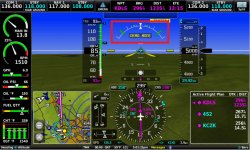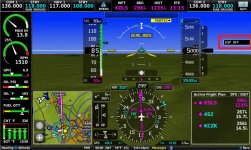About a year ago I completed a panel upgrade to a G3X system in my RV8. Since I occasionally do light aerobatics I added a switch on the panel to disable the Electronic Stability Protection (ESP) function.
Unfortunately, the best laid plans can go awry. Recently I forgot to disengage the ESP before doing a roll. Everything felt normal until I was about 135 degrees into a left roll when the roll rate slowed dramatically, at the same time I was pushing the stick to the left with a much higher level of force than normal. Even worse as I reached inverted the nose started to drop below the horizon even though I was forcefully pushing the stick forward to keep the nose above the horizon. I didn’t realize it at the time, but the ESP had engaged and was actively fighting my control inputs in the worse possible way. (While I have had ESP engage many times in steep turns, it felt completely different when upside down, I really had no clue what was happening)
Luckily, I reacted properly by keeping the roll going, albeit at a much slower roll rate. I had difficulty overcoming the ESP pitch inputs and by the time the aircraft rolled upright it was pitched about 45 degrees nose down. I did a 3.5 G pullout and the airspeed indicated ~190 kts when the aircraft leveled out. Definitely the scariest few seconds of my flying career.
Afterwards I talked with Garmin about what happened. They confirmed my observations were generally in line with their expectation of how ESP would react in a roll and that they have been informed of other pilots doing the same thing. Somehow I felt better – guess stupidity loves company. My question to them was can they add an aural alert that ESP has engaged? That would have helped immensely as there is an autopilot disconnect on the stick that could have easily been used if only I knew that ESP was actively fighting me.
Going forward I have taken 2 actions. I reduced the autopilot servo torque settings. But more importantly I have prohibited aerobatics in my RV8. Since I forgot to disable ESP prior to aerobatics once, I am assuming it could happen again. For me that is an unacceptable risk.
Unfortunately, the best laid plans can go awry. Recently I forgot to disengage the ESP before doing a roll. Everything felt normal until I was about 135 degrees into a left roll when the roll rate slowed dramatically, at the same time I was pushing the stick to the left with a much higher level of force than normal. Even worse as I reached inverted the nose started to drop below the horizon even though I was forcefully pushing the stick forward to keep the nose above the horizon. I didn’t realize it at the time, but the ESP had engaged and was actively fighting my control inputs in the worse possible way. (While I have had ESP engage many times in steep turns, it felt completely different when upside down, I really had no clue what was happening)
Luckily, I reacted properly by keeping the roll going, albeit at a much slower roll rate. I had difficulty overcoming the ESP pitch inputs and by the time the aircraft rolled upright it was pitched about 45 degrees nose down. I did a 3.5 G pullout and the airspeed indicated ~190 kts when the aircraft leveled out. Definitely the scariest few seconds of my flying career.
Afterwards I talked with Garmin about what happened. They confirmed my observations were generally in line with their expectation of how ESP would react in a roll and that they have been informed of other pilots doing the same thing. Somehow I felt better – guess stupidity loves company. My question to them was can they add an aural alert that ESP has engaged? That would have helped immensely as there is an autopilot disconnect on the stick that could have easily been used if only I knew that ESP was actively fighting me.
Going forward I have taken 2 actions. I reduced the autopilot servo torque settings. But more importantly I have prohibited aerobatics in my RV8. Since I forgot to disable ESP prior to aerobatics once, I am assuming it could happen again. For me that is an unacceptable risk.






